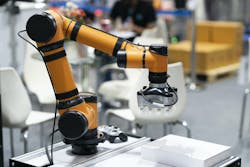Deliver Robust Automated Systems Through Servo Maintenance
Most manufacturers today understand the need to automate. Fewer realize that to make the most of their automated systems, they must keep their components in top condition. Servo motor maintenance, in particular, is an essential process to address.
Robotic systems vary widely between facilities and workflows, but many rely on servo motors. Despite that criticality, it’s easy to overlook the importance of maintaining these small components. That presents an opportunity. Manufacturers that optimize their servo maintenance can achieve higher automation performance than their peers.
The Importance of Servo Motor Maintenance for Automation
Manufacturing uses automation more extensively than any other industry, and that adoption will only grow as robotics become more accessible. Given that reliance, keeping these systems working as efficiently as possible is crucial.
Unfortunately, many manufacturers overlook the importance of equipment maintenance. Factories suffer 20 downtime incidents a month on average, each lasting over an hour, according to a Siemens report. These disruptions—which better care could have prevented— cost millions of dollars in repair expenses and lost productivity.
READ MORE: It’s Now Easier than Ever to Bring Servo Motor Repair In-house
Servo motor maintenance certainly isn’t the only factor at play here, but it’s an important one. Most industrial robots rely on servos to some extent, often to control their movement. As a result, issues with these components will likely impact the robot more heavily.
Servo motors are also more prone to failure than other components. As a critical moving part, these technologies encounter high movement speeds, heavy physical loads and long operation times, leading to more wear-and-tear.
Foundations of Servo Motor Maintenance
Servo motors’ criticality and higher workloads make them ideal candidates for maintenance optimization. That begins with understanding which care practices are most crucial for keeping these components in top condition.
Temperature management is one of the most important considerations. Manufacturers must routinely clean servo motors and their cooling equipment and monitor temperatures to keep them cool. In addition to preventing performance issues, lower temperatures improve energy efficiency in electrical equipment, lowering servo operating costs.
As with other moving parts, lubrication is another leading maintenance concern for servo motors. Regularly lubricating bearings and other servo components will prevent excess temperatures and friction.
Electrical maintenance is another core concern. Technicians should inspect for frayed wires, loose connections and similar issues to ensure all the motor’s electrical systems work well. Similarly, regular calibration is key to maintaining precision and repeatability.
Creating Optimal Maintenance Strategies
These foundational steps apply to all servos, but manufacturers must get more granular in their repair strategies. Optimal servo motor maintenance steps and timelines depend on the specific equipment in question.
Delayed maintenance results in higher repair costs and shortened equipment lifespans, but what defines “delayed” varies between motors. Manufacturers must refer to their OEM’s guidelines to learn how frequently they should consider each maintenance step. Remember that these recommendations are typically general baselines, so take them as a foundation, not a strict timeline.
READ MORE: How Data Logger Calibration Improves Predictive Maintenance for Better ROI
Similarly, manufacturers must deliver the right kind of repairs according to OEM recommendations. Some servo motors may require a specific lubricant. Some may have higher temperature tolerances than others. Understanding these unique factors is key to developing an optimal maintenance strategy.
Choosing the Right Maintenance Method
Once manufacturers understand their specific servo motors’ needs, they can move on to selecting a maintenance method. While it’s always best to use a preventive rather than reactive repair philosophy, the best non-reactive approach depends on the situation.
There are three main methods to choose from—schedule-based preventive care, condition-based and predictive maintenance. Predictive approaches offer the most uptime and long-term savings but are also the most difficult to implement. This method relies on Internet of Things (IoT) sensors and artificial intelligence (AI), raising upfront costs and requiring more IT experience.
Facilities with less tech talent or smaller budgets may prefer condition-based repairs. The resulting savings may be less impressive, but it’s easier to get right and costs less upfront. In some cases, it’s best to apply predictive maintenance to some servo motors and condition-based approaches to others.
Minimizing Maintenance Errors
Optimizing servo motor maintenance is also a matter of error reduction. Automating condition monitoring through the IoT will prevent human inspection-related mistakes, but manufacturers can go further.
Manufacturers using IoT sensors to monitor servo conditions must carefully calibrate these tools. Use the servo’s OEM’s recommendations to establish a baseline for acceptable parameters. If these benchmarks aren’t accurate, sensors may fail to determine the motor’s condition accurately.
Employee training is another critical area to address. Switching to a new maintenance strategy will make errors more likely if manufacturers aren’t careful. To prevent this, manufacturers must involve repair technicians throughout the transition, informing them of the change early and allowing plenty of time and resources to re-train and adjust to the new system.
Accounting for Unforeseen Failures
Even if manufacturers follow these other servo motor maintenance best practices, unplanned downtime is still possible. Predictive maintenance—the most effective method at decreasing downtime—improves uptime by up to 20%, but that’s not a complete elimination of failure. Consequently, manufacturers must have a plan to respond to unplanned downtime.
READ MORE: The Value of Predictive Maintenance
Documentation is one of the most important steps. If a servo motor fails unexpectedly, be sure to record the incident. Keep track of what went wrong, how long the issue took to resolve and what damage it caused. These records will help address similar issues in the future.
Over time, data from these incidents can inform more effective strategy adjustments. If manufacturers analyze these trends with AI, they can discover their underlying causes. They can then adjust their maintenance approach to reduce servo motor failures further.
Optimize Servo Motor Maintenance to Improve Automation
Reaching industrial automation’s full potential encompasses more than maintenance. Similarly, maintenance optimization should cover more than just servo motors. However, manufacturers must mind these smaller details to get all they can from their machines.
As automation becomes increasingly common, robots alone won’t suffice to keep manufacturers ahead of the competition. They mustn’t only automate, but automate better than other businesses. Optimized repair strategies are a crucial part of that endeavor, and servo motor maintenance is essential to those repairs. By following these guidelines and applying the same care to all factors, manufacturers can take their automation to the next level.
About the Author

Emily Newton
Emily Newton is a technology and industrial journalist. She is also the editor in chief of Revolutionized. She has over five years covering stories about warehousing, logistics and distribution.
